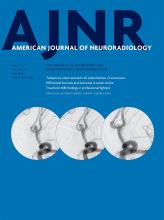Index by author
Bernick, C.
- FELLOWS' JOURNAL CLUBAdult BrainYou have accessPrevalence of Traumatic Findings on Routine MRI in a Large Cohort of Professional FightersJ.K. Lee, J. Wu, S. Banks, C. Bernick, M.G. Massand, M.T. Modic, P. Ruggieri and S.E. JonesAmerican Journal of Neuroradiology July 2017, 38 (7) 1303-1310; DOI: https://doi.org/10.3174/ajnr.A5175
Conventional 3T MR imaging was used to assess 499 fighters (boxers, mixed martial artists, and martial artists) and 62 controls for nonspecific WM changes, cerebral microhemorrhage, cavum septum pellucidum, and cavum vergae. Fighters had an increased prevalence of cerebral microhemorrhage (4.2% versus 0% for controls), cavum septum pellucidum (53.1% versus 17.7% for controls), and cavum vergae (14.4% versus 0% for controls). This study assessed MR imaging findings in a large cohort demonstrating a significantly increased prevalence of cavum septum pellucidum among fighters. Although cerebral microhemorrhages were higher in fighters than in controls, this finding was not statistically significant.
Bhoi, S.K.
- Adult BrainYou have accessPontomesencephalic Atrophy and Postural Instability in Wilson DiseaseJ. Kalita, S. Naik, S.K. Bhoi, U.K Misra, A. Ranjan and S. KumarAmerican Journal of Neuroradiology July 2017, 38 (7) 1343-1347; DOI: https://doi.org/10.3174/ajnr.A5207
Bonilha, L.
- EDITOR'S CHOICEAdult BrainOpen AccessDiffusional Kurtosis Imaging and Motor Outcome in Acute Ischemic StrokeM.V. Spampinato, C. Chan, J.H. Jensen, J.A. Helpern, L. Bonilha, S.A. Kautz, P.J. Nietert and W. FengAmerican Journal of Neuroradiology July 2017, 38 (7) 1328-1334; DOI: https://doi.org/10.3174/ajnr.A5180
The authors evaluated 17 patients with stroke who underwent brain diffusional kurtosis imaging within 4 days after the onset of symptoms. Neurologic evaluation included the Fugl-Meyer Upper Extremity Motor scale in the acute phase and 3 months poststroke. The largest percentage signal changes of the lesioned hemisphere corticospinal tract were observed with axial kurtosis, with an average 12% increase compared with the contralateral corticospinal tract. The strongest associations between the 3-month Fugl-Meyer Upper Extremity Motor scale score and diffusion metrics were found for the lesioned/contralateral hemisphere corticospinal tract mean kurtosis and axial kurtosis ratios. They conclude that diffusion metrics related to kurtosis were found to be more sensitive than conventional diffusivity metrics to early poststroke corticospinal tract microstructural changes.
Bonneville, F.
- FELLOWS' JOURNAL CLUBExtracranial VascularYou have accessTIPIC Syndrome: Beyond the Myth of Carotidynia, a New Distinct Unclassified EntityA. Lecler, M. Obadia, J. Savatovsky, H. Picard, F. Charbonneau, N. Menjot de Champfleur, O. Naggara, B. Carsin, M. Amor-Sahli, J.P. Cottier, J. Bensoussan, E. Auffray-Calvier, A. Varoquaux, S. De Gaalon, C. Calazel, N. Nasr, G. Volle, D.C. Jianu, O. Gout, F. Bonneville and J.C. SadikAmerican Journal of Neuroradiology July 2017, 38 (7) 1391-1398; DOI: https://doi.org/10.3174/ajnr.A5214
This study included 47 patients from 10 centers presenting between January 2009 through April 2016with acute neck pain or tenderness and at least 1 cervical image showing unclassified carotid abnormalities. The authors conducted a systematic, retrospective study of their medical charts and diagnostic and follow-up imaging. All patients presented with acute neck pain, and 8 presented with transient neurologic symptoms. Imaging showed an eccentric pericarotidian infiltration in all patients. An intimal soft plaque was noted in 16 patients, and a mild luminal narrowing was noted in 16 patients. The authors conclude that this study improves the description of an unclassified, clinico-radiologic entity, which could be described by the proposed acronym: Transient Perivascular Inflammation of the Carotid artery (TIPIC) syndrome.
Boudiaf, N.
- Head and Neck ImagingYou have accessThe Central Bright Spot Sign: A Potential New MR Imaging Sign for the Early Diagnosis of Anterior Ischemic Optic Neuropathy due to Giant Cell ArteritisP. Remond, A. Attyé, A. Lecler, L. Lamalle, N. Boudiaf, F. Aptel, A. Krainik and C. ChiquetAmerican Journal of Neuroradiology July 2017, 38 (7) 1411-1415; DOI: https://doi.org/10.3174/ajnr.A5205
Boyd, R.N.
- Pediatric NeuroimagingOpen AccessValidation of an MRI Brain Injury and Growth Scoring System in Very Preterm Infants Scanned at 29- to 35-Week Postmenstrual AgeJ.M. George, S. Fiori, J. Fripp, K. Pannek, J. Bursle, R.X. Moldrich, A. Guzzetta, A. Coulthard, R.S. Ware, S.E. Rose, P.B. Colditz and R.N. BoydAmerican Journal of Neuroradiology July 2017, 38 (7) 1435-1442; DOI: https://doi.org/10.3174/ajnr.A5191
Brainer-lima, A.M.
- Pediatric NeuroimagingOpen AccessNonmicrocephalic Infants with Congenital Zika Syndrome Suspected Only after Neuroimaging Evaluation Compared with Those with Microcephaly at Birth and Postnatally: How Large Is the Zika Virus “Iceberg”?M.F.V.V. Aragao, A.C. Holanda, A.M. Brainer-Lima, N.C.L. Petribu, M. Castillo, V. van der Linden, S.C. Serpa, A.G. Tenório, P.T.C. Travassos, M.T. Cordeiro, C. Sarteschi, M.M. Valenca and A. CostelloAmerican Journal of Neuroradiology July 2017, 38 (7) 1427-1434; DOI: https://doi.org/10.3174/ajnr.A5216
Branstetter, B.F.
- Head and Neck ImagingYou have accessSolid Lymph Nodes as an Imaging Biomarker for Risk Stratification in Human Papillomavirus–Related Oropharyngeal Squamous Cell CarcinomaT.J. Rath, S. Narayanan, M.A. Hughes, R.L. Ferris, S.I. Chiosea and B.F. BranstetterAmerican Journal of Neuroradiology July 2017, 38 (7) 1405-1410; DOI: https://doi.org/10.3174/ajnr.A5177
Brockmann, C.
- EDITOR'S CHOICENeurointerventionYou have accessTemporary Stent-Assisted Coil Embolization as a Treatment Option for Wide-Neck AneurysmsM. Müller, C. Brockmann, S. Afat, O. Nikoubashman, G.A. Schubert, A. Reich, A.E. Othman and M. WiesmannAmerican Journal of Neuroradiology July 2017, 38 (7) 1372-1376; DOI: https://doi.org/10.3174/ajnr.A5204
The authors intended to treat 33 aneurysms between January 2010 and December 2015 with temporary stent-assisted coiling, which formed the series for this study. Incidental and acutely ruptured aneurysms were included. Sufficient occlusion was achieved in 97.1% of the cases. In 94%, the stent could be fully recovered. Complications occurred in 5 patients (14.7%). They conclude that temporary stent-assisted coiling is an effective technique for the treatment of wide-neck aneurysms. Safety is comparable with that of stent-assisted coiling and coiling with balloon remodeling.
Broeg-morvay, A.
- NeurointerventionYou have accessImpact of Anesthesia on the Outcome of Acute Ischemic Stroke after Endovascular Treatment with the Solitaire Stent RetrieverA. Slezak, R. Kurmann, L. Oppliger, A. Broeg-Morvay, J. Gralla, G. Schroth, H.P. Mattle, M. Arnold, U. Fischer, S. Jung, R. Greif, F. Neff, P. Mordasini and M.-L. MonoAmerican Journal of Neuroradiology July 2017, 38 (7) 1362-1367; DOI: https://doi.org/10.3174/ajnr.A5183








